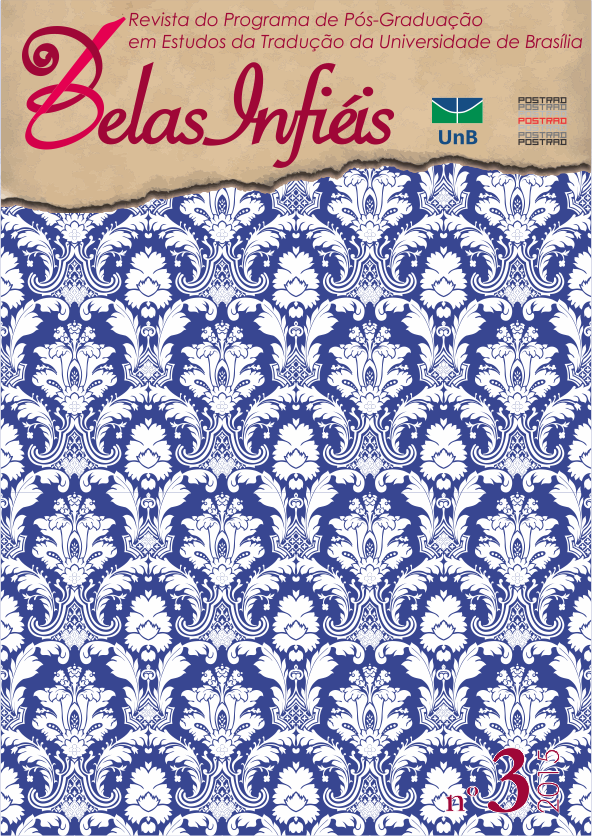REPRESENTAÇÃO CULTURAL NA TRADUÇÃO PARA O INGLÊS DA OBRA DE JORGE AMADO, GABRIELA, CRAVO E CANELA
DOI :
https://doi.org/10.26512/belasinfieis.v4.n3.2015.11350Mots-clés :
Tradução, Identidade Nacional, Representação, Estratégias de Domesticação Jorge AmadoRésumé
A formação e representação de identidades nacionais acontecem, geralmente, através de como as histórias das nações são contadas (HALL, 2005). Obras literárias têm o potencial de narrar tais histórias, e suas traduções (VENUTI, 1999) podem influenciar na formação de identidades nacionais, ao domesticar ou estrangeirizar valores linguísticos e culturais do texto. Pensando na tradução da obra brasileira de Jorge Amado, Gabriela, Cravo e Canela (1958), traduzi-la consiste em traduzir também o Brasil, já que tal obra é marcada pela representação de aspectos da cultura nacional. Essa é uma pesquisa descritiva orientada pelo produto (CHESTERMAN, 2009) e tem como objetivo refletir sobre de que forma através das estratégias de domesticação e estrangeirização de termos culturais a cultura brasileira é representada na tradução. Ao final da análise percebemos que os termos culturais ora são traduzidos pela estratégia de estrangeirização, ora pela domesticação e que esta última estratégia é utilizada quando a manutenção dos termos culturais tornaria a leitura problemática para o leitor do texto alvo que não conhece tais aspectos da cultura fonte.
Téléchargements
Références
AMADO, J. Gabriela, cravo e canela. São Paulo: Martins, 1958.
AMADO, J. Gabriela, clove and cinnamon. Tradução de William L. Grossman e James L. Taylor. New York: Crest book, 1962.
ARCOVERDE, M.D.L. O querer-dizer de Jorge Amado no viés popular. In: FIGUEIREDO, E.L.L.; GERMANO, P.G.;SWARKANAR, S. (Org). Nova leitura crítica de Jorge Amado.Campina Grande: Eduepb, 2014. p. 249-266.
CALVO, M. M. Translation and cross-cultural communication. In: CALVO, M. M.; GÓMEZ, C. B. Translation and cultural identity: selected essays on translation and cross-cultural communication. Newcastle: Cambridge Scholars, 2010.
CHESTERMAN, A. The name and nature of translator studies. Hermes, Aarhus. p. 13-22, 2009. Disponível em: <http://download1.hermes.asb.dk/archive/download/Hermes-42-2-chesterman_net.pdf>. Acesso em: 05/11/2015.
CORRÊA, R. H. M. A. A tradução dos termos culturais extra-linguísticos: Jorge Amado traduzido. TradTerm, São Paulo, v. 9, p.93-137, 2003. Disponível em: <http://myrtus.uspnet.usp.br/tradterm/site/images/revistas/v09n1/v09n1a09.pdf> Acesso em: 27/04/2015.
CUNHA, A. G. Dicionário etimológico da língua portuguesa. 4. ed. Rio de Janeiro: Lexicon, 2010.
DIAS LOPES, J. A. V. Ascenção e queda da galinha de cabidela. [Internet]. São Paulo: Estadão; 2010. Disponível em: <http://www.estadao.com.br/noticias/geral,ascensao-e-queda-da-galinha-de-cabidela,4002> Acesso em: 11/06/2015.
FERREIRA, A. M. A. A tradução como prática mestiça: um modelo possível para um ethos contemporâneo. In: BELL-SANTOS, C. A.; HATJE-FAGGION, V.; ROSCOE-BESSA, C.; SOUSA, G. H. P. (Org.). Tradução e cultura. Rio de Janeiro: 7 letras, 2011. p. 23-37.
HALL, S. A identidade cultural na pós-modernidade. 10. ed. Rio de Janeiro: DP&A editora, 2005.
KATAN, D. Translating cultures: an introduction for translators, interpreters and mediators. Manchester: St. Jerome, 1999.
LEFEVERE, A. Translation, rewriting, and the manipulation of the literary fame. London: Routledge, 1992.
PRANDI, R. Religião e sincretismo em Jorge Amado.In: SCHWARCZ, L. M.; GOLDSTEIN, I. S. (Org.). Caderno de leituras: o universo de Jorge Amado. Companhia das letras. p. 46-61. Disponível em: <http://www.jorgeamado.com.br/professores2/professores02.pdf> Acesso em: 27/07/2015.
VENUTI, L. The translator’s invisibility: a history of translation. London/NY: Routledge, 1995.
___________. Translation and the formation of cultural identities. In: C. Shaffner; H. Kelly-Holmes. Cultural functions of translation. Clevedon: Multilingual Matters, 1995.
___________. The scandals of translation. London: Routledge, 1999.
Téléchargements
Publié-e
Comment citer
Numéro
Rubrique
Licence
Copyright Statement
Given the public access to this journal, the texts are free to use but requires the recognition of the original authorship and initial publication in this journal to be properly stated.
The journal allows the use of works published for non-commercial purposes, including the right to submit the work to publicly accessible databases. Published contributions are the sole and exclusive responsibility of the author(s).
- When submitting papers to be evaluated by the Belas Infiéis journal, the author(s):
- Declare that the contents of the contributions are original and of their original creation, being entirely responsible for their content if there is an objection by third parties.
- Claim to be aware that they should not commit academic plagiarism.
- Declare that the manuscript has not been published, completely or partially, in Portuguese or another language. If it is a translation it should be submitted to the Translated Articles section.
- Declare that the manuscript is not being evaluated by other journals.
- Declare that the manuscript was not submitted to another journal simultaneously.
- Commit(s) to inform the journal of any kind of error or inaccuracy in their contribution (published, in evaluation or in editing) and to collaborate with the editors to make due corrections of the article (when in evaluation or editing) or erratum/retraction (after publication).
- Declare that there is no conflict of interest regarding the published work.
- Authorize its release if it is accepted for publication without any kind of monetary compensation.
- Agree to assign non-exclusive rights to publication to the magazine, remaining free to make their contribution available in other media as long as the publication of the first version in Belas Infiéis magazine is mentioned. They also authorize Belas Infiéis to assign their texts for reproduction in content indexers, virtual libraries and similar platforms.
- Maintain copyright and grant the journal the right of first publication, the work being licensed under theCreative Commons Attribution License.
- Is/Are allowed and encouraged to publish and distribute their work online after the editorial process, which may increase the impact and citation of the published work.
- Authorize the editorial team to make textual adjustments and to adapt the article to the publication rules, when necessary.



















